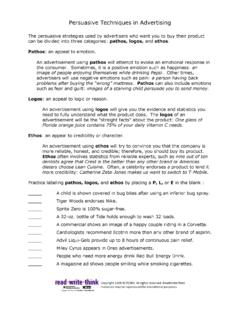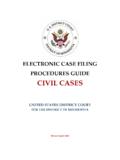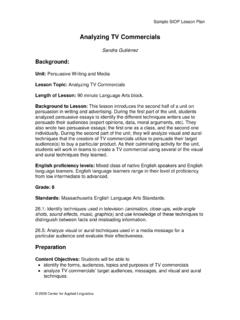Transcription of Lesson Skill: Media literacy in presentations - VDOE
1 English Enhanced Scope and Sequence Lesson Skill: Media literacy in presentations Strand Communication SOL , , , Materials: A variety of Media messages in print, audio, and video formats Overhead or LCD projector Internet access Computer lab/laptop cart Analyzing Media Messages table persuasive Techniques in Media chart Media Design Cycle Plan Media Messages Analysis Rubric Lesson Preparation In preparation for the Lesson , select a variety of Media messages in the following formats: Visual Media television, video, print ads, Web-based material Written Media newspapers, magazines, books, blogs Audio Media music, radio shows, podcasts Select two examples from each of the formats to analyze as a class. Choose additional examples to organize into three stations (one for each format).
2 The students will rotate through the stations to select Media messages to analyze and present. Lesson 1. Discuss the three different formats of mass Media messages. Ask students to recall examples of the three formats they have observed. Record accurate responses on a class web. 2. Distribute the Analyzing Media Messages table to the students. Discuss the meaning of angle, audience, aim, and arrangement (4 A's). Explain that this Lesson requires students to analyze examples of visual, written, and audio Media . 3. Show students one example of the different formats of Media messages. As each example is shown, model (through a think aloud) identifying details that describe the angle, audience, aim, and arrangement. Accurate responses will be recorded on the Analyzing Media Messages table.
3 The students and teacher discuss the impact of the 4. A's on each Media format. 4. Show students another example of each of the three Media formats. Working in pairs, the students identify details that describe the 4 A's in each example. The students record details onto an Analyzing Messages table created on loose-leaf paper. English Enhanced Scope and Sequence 5. Distribute the persuasive Techniques in Media chart. Discuss the different persuasive techniques. Collaborate with students to identify examples of the persuasive techniques observed in the Media formats that were analyzed during the Lesson . As responses are given, refer students back to (replay if necessary) the specific examples. Students record the examples of the techniques being used on the chart.
4 Discuss the impact of the techniques on the audience. Students record accurate responses on their individual charts as the teacher records them on the class chart. 6. Refer the students to the three stations arranged around the room: o Station 1: Visual Media o Station 2: Written Media o Station 3: Audio Media Explain each station has examples of each the Media formats from everyday life. 7. Arrange students in groups of three. Students rotate through each station to choose an example of visual, written, and audio Media formats from the designated stations. 8. Groups analyze the selected examples for the four A's, as well as the persuasive techniques being used. Groups also determine the impact of the persuasive technique on the audience. Students record their responses onto a persuasive Techniques in Media chart created on loose-leaf paper.
5 9. Groups use their completed charts to create a presentation for the class. Students may create a poster, online poster, brochure, digital slide presentation , online presentation , blog, video, or wiki for their presentation . 10. Distribute the Media Design Cycle Plan. Groups complete this resource to plan and organize their presentations . 11. Students use computers to create the selected presentation . 12. After finishing their presentations , groups complete the reflection component on the Design Cycle Plan. Strategies for Differentiation Students with accommodations will focus on finding one example of a persuasive technique in one Media format. Students then present their example in a small group setting. The Media Design Cycle Plan is a helpful organizational tool for all learners.
6 Contact local magazine and newspapers, as well as television and radio stations to arrange guest speakers for a real world connection. English Enhanced Scope and Sequence Analyzing Media Messages Table Media messages are constructed using a variety of persuasive techniques. The techniques used to produce the Media messages are based on two factors: 1. the desired effect from the audience; and 2. the purpose of the message. Analyze the three different Media formats (visual, written, auditory) for the following elements: Angle Camera angle refers to the angle between the camera and the subject and can be used to convey an idea. For example, up angles often suggest power, prestige, and success. Audience A specified target audience or demographic group is the audience for which a Media message is designed.
7 Aim The aim is the purpose for which a Media message is created. The purpose of a Media message can be to persuade, inform, entertain, or sell. Arrangement The way the Media message is arranged suggests a certain idea. For example, the way a product is placed in an advertisement creates a specific idea about that product. Also, the different ways actors are portrayed in ads suggests feelings about the products. Likewise, music chosen for a Media message can influence the mood associated with that message. Directions: Analyze the following formats of mass Media messages for the 4 A's. Visual Media (television, video, print ads, Web-based material). Description of Media Angle Audience Aim Arrangement message Written Media (newspapers, magazines, books, blogs).
8 Description of Media Angle Audience Aim Arrangement message English Enhanced Scope and Sequence Auditory Media (music, radio shows, podcasts). Description of Media Angle Audience Aim Arrangement message English Enhanced Scope and Sequence persuasive Techniques in Media A variety of persuasive techniques are used in Media . These techniques can influence beliefs, behaviors, and interpretations. Media messages persuade by appealing logically, ethically, and emotionally. Review the persuasive techniques, and then identify them in the examples provided below. Name Calling or Innuendo creating a negative attitude; hinting or implying; using loaded, emotional, or slanted language Glittering Generalities or Card Stacking telling only part of the truth; generalizing from a shred of evidence Bandwagon creating a desire to join a large group satisfied with this idea.
9 Making one feel left out if not with the crowd Testimonials using the declaration of a famous person or authoritative expert to give heightened credibility Appeal to Prestige, Snobbery, or Plain Folks using a spokesperson who appeals to the audience: a well-known or appealing person the audience wants to emulate, a person like the audience members with whom they can identify, a person whose lifestyle appeals to the audience Appeal to Emotions connecting with emotions: loyalty, pity, or fear; love of family, peace, or justice persuasive Media Message Example Effect on the technique Audience Every kiss begins with K. EAT MOR CHIKIN. got milk? Better ingredients. Better pizza. Introducing the new standard of luxury car ownership This candidate is a coward. He's afraid to stand up, face the public, and defend his miserable record.
10 English Enhanced Scope and Sequence Media Message Design Cycle Plan Process Responses Investigate We used these sources for our presentation : These are the questions we asked ourselves while searching for Media messages: We considered what we already knew about the topic. We already knew the following: Design The best idea we came up with for our presentation : The materials we need to create our presentation : English Enhanced Scope and Sequence Process Responses Create Steps taken to organize our presentation using the appropriate techniques and equipment: Reflect The advantages of using this particular medium to create our presentation : The strengths of our presentation : The areas of improvement for our presentation : English Enhanced Scope and Sequence Media Message Analysis Rubric CATEGORY Strong Proficient Developing Beginning 4 points 3 points 2 points 1 point Media presentation presentation presentation presentation does Formats includes a variety includes a variety includes some not include a (Visual, of Media of Media variety of Media variety of Media written, audio) messages.

















